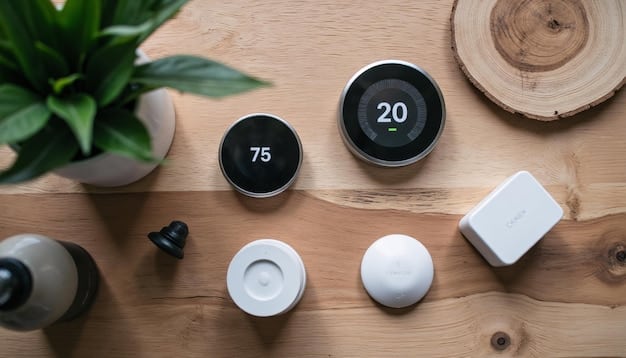The Ultimate Guide to Saving Money on Groceries and Household Expenses

Achieving significant savings on groceries and household expenses involves strategic planning, mindful consumption, and leveraging smart shopping techniques to reduce overall spending without compromising quality of life.
In an economic landscape where every dollar counts, mastering the art of saving money on groceries and household expenses has become more than just a smart financial move—it’s a necessity. This comprehensive guide, The Ultimate Guide to Saving Money on Groceries and Household Expenses, will equip you with the practical strategies and insights needed to significantly cut down your everyday costs without sacrificing quality or convenience.
Understanding Your Current Spending Habits
To genuinely embark on a journey of significant savings, one must first confront and comprehend their current spending habits. This initial phase is less about judgment and more about honest assessment, laying the groundwork for sustainable change. Many people underestimate their expenditure on groceries and household necessities, often due to a lack of detailed tracking.
A crucial first step involves analyzing bank statements, credit card bills, and even old receipts for the past few months. Segmenting your spending into categories such as “groceries,” “cleaning supplies,” “personal care,” and “miscellaneous household items” can reveal surprising patterns. You might discover an unexpected leak in your budget, perhaps on impulse buys at the checkout or premium cleaning products when more economical options suffice. This meticulous review provides a quantifiable baseline from which to measure future savings effectively.
The Power of a Budget
Budgeting is not about deprivation; it’s about allocation. It’s about consciously deciding where your money goes rather than wondering where it went. For household expenses, this means setting clear limits for each category identified in your spending audit.
- Allocate Funds: Assign specific amounts for groceries, utilities, personal care, and other household needs.
- Track Everything: Use apps, spreadsheets, or even a simple notebook to log every single purchase.
- Review Regularly: At the end of each week or month, compare your actual spending against your budgeted amounts.
This constant feedback loop allows for adjustments and reinforces positive spending behaviors. It also highlights areas where overspending occurred and helps pinpoint the “why” behind it, leading to more informed decisions in the future. Understanding your flow of money is the foundation of gaining control.
Strategic Grocery Shopping: Maximizing Every Dollar
Grocery shopping often represents one of the largest variable expenses for most households. By implementing strategic planning and smart decision-making, it is possible to significantly reduce these costs without compromising nutrition or quality. This section delves into actionable tactics designed to make your grocery budget go further.
Effective grocery saving begins long before you even step foot in the store. It starts with planning your meals for the week. This involves taking stock of what you already have in your pantry, refrigerator, and freezer to avoid duplicate purchases and minimize food waste. Developing a meal plan ensures that every ingredient you buy has a purpose, reducing the likelihood of items spoiling before they can be used. Consider incorporating versatile ingredients that can be used in multiple dishes throughout the week, such as a whole chicken that can become roasted chicken one night, and leftover meat for sandwiches or salads the next. This foresight transforms chaotic shopping into a streamlined, efficient process.
Crafting the Perfect Shopping List
A well-crafted shopping list is your shield against impulse buys and forgotten necessities. Base your list on your meal plan, noting exact quantities. Prioritize items that are on sale or can be purchased in bulk if they are non-perishable or can be frozen.
- Check Sales Flyers: Compare prices across different stores to identify the best deals on your staple items.
- Clip Digital Coupons: Many stores offer digital coupons through their apps or websites, which can be easily loaded to your loyalty card.
- Buy In-Season Produce: Seasonal fruits and vegetables are typically less expensive and taste better.
When you arrive at the store with a definitive list, stick to it. Avoid browsing aisles aimlessly, as this often leads to picking up unnecessary items. Discipline is key when navigating the supermarket environment, which is intentionally designed to encourage additional spending. Recognize the psychological triggers marketers use, such as prominent displays of high-margin items at eye level or near the checkout, and train yourself to walk past them unless the item is on your pre-approved list.
Another powerful strategy is to consider shopping at a variety of stores. While one supermarket might offer the best prices on produce, a discount retailer could be more affordable for pantry staples or cleaning supplies. This multi-store approach, though requiring slightly more time, can yield substantial savings over the long term. Also, cooking at home more often is inherently cheaper than eating out, and planning your meals makes this more feasible.
Smart Strategies for Household Expenses
Beyond groceries, numerous household expenses contribute to your overall budget. These typically include utilities, cleaning supplies, personal care items, and various subscriptions. Optimizing these categories requires a combination of behavioral changes, smart purchasing decisions, and leveraging technology. Every small adjustment can compound into significant annual savings.
One of the largest non-grocery household expenses for many families is utilities. This includes electricity, gas, and water. Reducing consumption in these areas is not only kind to your wallet but also to the environment. Simple adjustments around the home can make a big difference. For instance, being mindful of your thermostat settings throughout the year—raising it slightly in summer and lowering it in winter—can noticeably impact your heating and cooling bills. Unplugging electronics when not in use, known as “vampire power,” can also prevent unnecessary energy drain. Similarly, taking shorter showers, fixing leaky faucets promptly, and running dishwashers and washing machines only when full can drastically cut down on water usage. Regularly checking for and sealing air leaks around windows and doors can prevent heat loss or gain, further optimizing energy efficiency.

Optimizing Cleaning & Personal Care Spending
Cleaning supplies and personal care items might seem small individually, but their cumulative cost can be substantial. Instead of buying brand-name products, consider generic or store-brand alternatives, which often offer comparable quality for a fraction of the price. Making your own cleaning solutions using ingredients like vinegar, baking soda, and lemon juice is another highly effective and eco-friendly way to save.
For personal care, buying in bulk for non-perishables like toilet paper, toothpaste, and soap can lead to economies of scale. Subscribing to refill services for items like shampoo or hand soap can also reduce costs and packaging waste. Furthermore, evaluating your actual consumption of these products and avoiding over-stocking can mitigate waste and the temptation to buy more than is needed.
Subscriptions and Services: Trimming the Fat
In today’s digital age, subscriptions to streaming services, apps, and various memberships can quietly erode your budget. Regularly review all your recurring charges. Ask yourself: “Do I truly use and value this service?”
- Audit Monthly Subscriptions: List all your paid subscriptions and cancel any that are underutilized.
- Bundle Services: Explore if bundling internet, TV, and phone services can offer a better deal.
- Negotiate Bills: Don’t hesitate to call your service providers (internet, cable, insurance) and inquire about lower rates or special offers. Often, fidelity discounts or new customer promotions can be negotiated.
This critical review process can quickly expose forgotten trials that converted to paid subscriptions or services that no longer align with your needs. Many people are surprised by how much they are spending each month on services they barely use. Eliminating these unnecessary expenses can provide immediate and significant savings, freeing up funds for more impactful financial goals.
Embracing DIY and Smart Maintenance
A powerful, yet often overlooked, strategy for saving money on household expenses is to embrace the “do-it-yourself” (DIY) mindset and prioritize smart home maintenance. Outsourcing every small repair or relying solely on store-bought solutions can be costly. By developing basic handyman skills and diligently maintaining your home, you can extend the lifespan of appliances, prevent costly repairs, and significantly cut down on recurring expenses.
Consider learning simple repair tasks, such as fixing a leaky faucet, patching a small hole in drywall, or unclogging a drain. While some tasks require professional expertise, many common household issues can be resolved with a few inexpensive tools and a quick online tutorial. Websites and YouTube channels offer a wealth of information for beginners, empowering homeowners to tackle minor problems independently. The initial investment in a basic toolkit can pay for itself many times over by avoiding service call fees from plumbers or handymen. Furthermore, the satisfaction of fixing something yourself can be an unexpected bonus.
Preventative Maintenance for Long-Term Savings
Preventative maintenance is about foresight. It’s about taking small, proactive steps now to avoid large, expensive problems later. Regular upkeep of your home and appliances can save you from premature replacements and emergency repairs.
- Appliance Care: Clean refrigerator coils, replace HVAC filters regularly, and descale coffee makers.
- Home Structure: Inspect your roof for loose shingles, clean gutters annually, and check for drafts around windows and doors.
- Yard Work: Mow your lawn, prune bushes, and keep your garden tidy to prevent pest infestations and maintain property value.
This proactive approach minimizes wear and tear, prolonging the life of your most valuable assets. For example, a clogged gutter can lead to water damage in your foundation, a far more expensive issue than simply cleaning it out. Similarly, consistently replacing your HVAC filters not only improves air quality but also ensures your system runs more efficiently, reducing energy bills and extending the life of the unit. These routine tasks might seem minor, but they contribute significantly to the longevity and efficiency of your home.
Building a repertoire of DIY skills and integrating a routine of preventative maintenance into your schedule can transform your financial outlook. It shifts your reliance from external, often costly, services to internal capabilities, granting you greater control over your household budget. This approach promotes resourcefulness and can free up funds for other priorities or emergency savings, fostering a sense of self-sufficiency.
Leveraging Technology for Savings
In the modern era, technology offers an unprecedented array of tools and resources that can significantly aid in saving money on groceries and household expenses. From budgeting apps to price comparison websites and digital coupon platforms, strategic use of these innovations can streamline your savings efforts and ensure you’re always getting the best deal. Embracing these technological solutions can transform a daunting task into an efficient and even enjoyable process.
One of the most immediate benefits of technology is its ability to centralize and analyze your spending. Budgeting apps, such as Mint, YNAB (You Need A Budget), or Personal Capital, link directly to your bank accounts and credit cards, automatically categorizing your transactions. This provides a clear, real-time overview of where your money is going, making it far easier to identify areas of overspending and track progress towards your savings goals. Many of these apps also offer customizable budgeting features, alerts for approaching limits, and detailed reports that highlight spending trends over time. This level of insight is incredibly valuable for maintaining financial discipline and making informed decisions.
Digital Coupons and Price Comparison
Gone are the days of clipping physical coupons from newspapers. Digital platforms have revolutionized how consumers access discounts and compare prices.
- Coupon Apps: Apps like Ibotta, Fetch Rewards, or store-specific apps offer cashback or discounts on everyday purchases.
- Browser Extensions: Tools like Honey or Rakuten automatically search for coupon codes and cash back opportunities when you shop online.
- Price Trackers: Websites and apps can alert you when prices drop on desired items, especially useful for larger household purchases.
These tools remove much of the manual effort involved in finding savings, allowing you to maximize discounts with minimal fuss. Before making any significant purchase, a quick check across various online retailers or using a price comparison app can ensure you are not overpaying. This is particularly effective for household appliances, furniture, or electronics where price discrepancies between retailers can be substantial.
Moreover, loyalty programs offered by grocery stores and other retailers are increasingly digital, providing personalized discounts based on your purchasing history. By linking these programs to your account, you can unlock exclusive deals and earn points that can be redeemed for future savings. The strategic integration of these technological tools into your daily shopping routine can lead to substantial, recurring savings, empowering you to live more frugally without feeling deprived. This holistic approach makes saving money not just a goal, but a systemic part of your financial lifestyle.
Minimizing Food Waste and Maximizing Leftovers
One of the most impactful, yet often underestimated, strategies for saving money on groceries and household expenses is rigorously minimizing food waste and effectively utilizing leftovers. Food waste represents a direct financial loss, as every discarded item amounts to money thrown away. By adopting habits that prolong food freshness and creatively repurpose uneaten portions, households can significantly reduce their grocery bill and contribute to a more sustainable lifestyle.
The journey to zero food waste begins with thoughtful meal planning and smart storage. As previously discussed, creating a weekly meal plan based on what you already have and what you intend to buy helps prevent over-purchasing. Beyond planning, proper storage is paramount. Understanding how to store different types of produce, dairy, and meats can extend their shelf life considerably. This might involve using airtight containers, understanding which fruits and vegetables should be stored separately, or knowing when to freeze items before they spoil. For instance, herbs can be chopped and frozen in olive oil, and almost-expired milk can be frozen for baking. These simple changes ensure that more of what you buy actually gets consumed.
Creative Uses for Leftovers and Scraps
The art of transforming leftovers and using food scraps is a cornerstone of a frugal kitchen. Instead of viewing uneaten portions as waste, see them as ingredients for future meals.
- Repurpose Meals: Transform leftover roasted chicken into sandwiches, salads, or a stir-fry later in the week.
- Make Stock: Vegetable trimmings (onion skins, carrot tops, celery ends) and chicken bones can be easily turned into flavorful homemade broth.
- Compost: For inedible scraps, composting reduces waste sent to landfills and creates nutrient-rich soil for gardening.
Beyond individual meals, adopting a “first-in, first-out” (FIFO) system in your pantry and refrigerator ensures that older items are used before newer ones, preventing forgotten foods from expiring. Regularly auditing your fridge and pantry, perhaps once a week, for items nearing their expiration date can prompt you to use them up creatively. This might mean making a “use-it-up” soup with various vegetables or baking a quick bread with overripe fruit. These habits not only save money by reducing direct waste but also reduce the need for constant, reactive grocery runs, which can themselves lead to impulse purchases. By mastering the art of food preservation and reuse, you transform potential waste into tangible savings and delicious new meals.

Long-Term Financial Habits for Sustained Savings
While immediate strategies for cutting costs on groceries and household expenses are vital, achieving sustained financial well-being requires cultivating long-term habits that extend beyond weekly shopping trips. These overarching principles form the bedrock of a robust financial strategy, ensuring that saving becomes an integral, almost automatic, part of your lifestyle. It’s about shifting mindsets and building routines that consistently prioritize fiscal responsibility and intelligent resource management.
One of the most powerful long-term habits is the consistent practice of conscious consumption. This means questioning every purchase, big or small. Before adding an item to your cart or clicking “buy now,” ask yourself: “Do I truly need this? Is there a cheaper, equally effective alternative? Will this add genuine value to my life?” This reflective pause can circumvent impulsive spending and encourage a more deliberate approach to acquiring goods. It fosters a mindset where quality and necessity often outweigh fleeting desire or promotional gimmicks. Over time, this conscious filtering process significantly reduces unnecessary expenditures across all categories of household spending.
Investing in Quality and Durability
While it might seem counterintuitive to spend more to save money, investing in quality and durability often leads to significant long-term savings. This principle applies to everything from kitchen appliances and clothing to furniture and tools.
- Appliances: A more energy-efficient refrigerator, though costing more upfront, will save on electricity bills for years.
- Clothing: Well-made garments might be pricier but last longer, reducing the need for frequent replacements.
- Tools: Durable tools are less likely to break, avoiding replacement costs and ensuring projects can be completed efficiently.
The concept of “cost per use” becomes relevant here. A cheaper item that breaks quickly or performs poorly often ends up costing more in the long run due to repeated purchases or frustrating inefficiencies. By prioritizing durability, you reduce the frequency of expenditure, mitigate waste, and often enjoy a higher quality of life. This strategic approach ensures that your money is an investment, not just an expense, fostering true financial resilience.
Another crucial habit is regularly reviewing and adapting your financial plan. Life circumstances change – income fluctuates, family needs evolve, and economic conditions shift. What worked last year might not be optimal this year. Schedule quarterly or bi-annual reviews of your budget, spending habits, and savings goals. This allows you to identify new opportunities for savings, adjust to new realities, and maintain momentum towards your financial objectives. This ongoing engagement with your financial health ensures that your saving strategies remain relevant, effective, and aligned with your evolving life.
Conclusion
Mastering the art of The Ultimate Guide to Saving Money on Groceries and Household Expenses is an ongoing journey that combines mindful planning, strategic execution, and a commitment to continuous learning. By understanding current spending, planning meals and shopping lists, optimizing household expenses, embracing DIY projects, leveraging technology, and minimizing waste, you can transform your financial landscape. These habits, once ingrained, will not only lead to substantial savings but also foster a greater sense of financial control and sustainability in your daily life.
| Key Point | Brief Description |
|---|---|
| 📝 Budgeting & Tracking | Understand and track your spending to identify areas for significant savings across all household categories. |
| 🛒 Smart Grocery Habits | Meal plan, use shopping lists, and leverage sales/coupons to reduce food costs effectively. |
| 💡 Utility & Maintenance | Implement energy-saving practices, DIY repairs, and preventative maintenance for long-term savings. |
| 📱 Tech & Waste Reduction | Utilize apps for coupons/tracking and minimize food waste through smart storage and repurposing. |
Frequently Asked Questions About Saving Money
Begin by creating a weekly meal plan based on existing pantry items. Then, make a precise shopping list and stick to it strictly. Always check for digital coupons and sales flyers from different stores to compare prices and maximize your discounts on essential items.
Reducing utility bills involves simple habits like unplugging electronics when not in use, adjusting thermostat settings seasonally, and promptly fixing leaky faucets. Regularly clean appliance filters and seal air leaks around windows and doors to improve energy efficiency in your home.
Often, yes. While a higher upfront cost, quality and durable products (like appliances or clothing) tend to last longer, reducing the need for frequent replacements. This translates to significant long-term savings and less waste, offering better value over the product’s lifespan.
Technology offers powerful tools like budgeting apps for tracking spending and coupon apps/browser extensions for finding discounts. Price comparison websites ensure you get the best deals on larger purchases, while digital loyalty programs provide personalized savings, streamlining your fiscal management.
Minimizing food waste directly saves money by ensuring you consume what you buy, avoiding discarded items. Strategies include proper food storage to extend freshness, creative repurposing of leftovers into new meals, and using scraps for homemade stocks, reducing the need for new purchases.
Final Thoughts
Learning to effectively manage and reduce expenses on groceries and household items is not merely an exercise in frugality; it’s a foundational skill for building enduring financial security. By integrating the strategies outlined here—from diligent budgeting and smart shopping to embracing DIY and leveraging technology—you empower yourself to cultivate habits that foster long-term savings and a more resilient household budget. The commitment to these practices transforms daily spending into an intentional act of financial empowerment.





